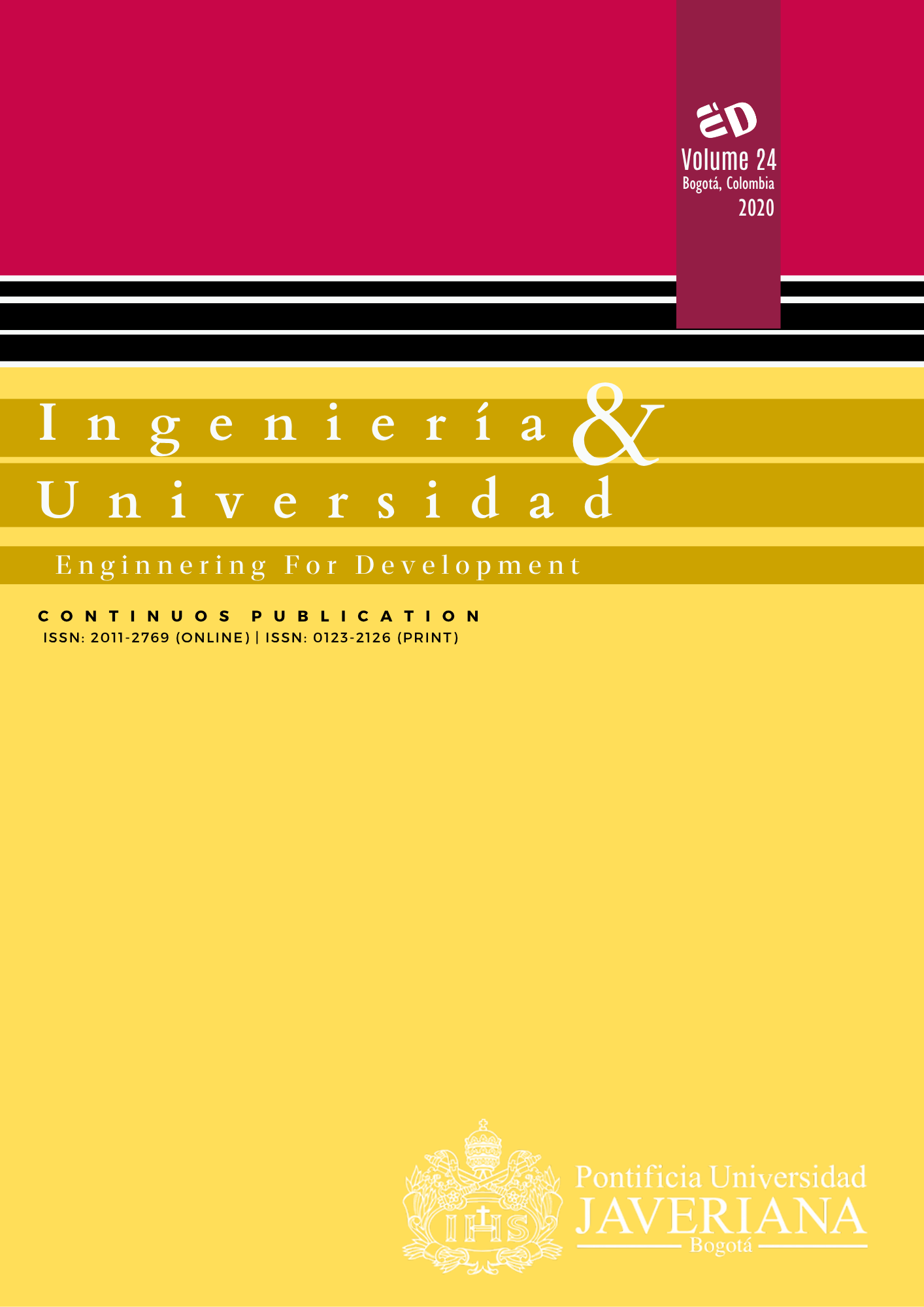Abstract
Dengue is the most important viral disease transmitted by mosquitoes. Ineffective vector control, cluttered urbanization, poor rainwater and wastewater management and increased air travel have encouraged the proliferation of the Aedes aegypti mosquito in Latin America, causing dengue and, more recently, zika and chikungunya, to become widespread public health problems. Vector control has targeted the reduction of breeding sites. Objective: For this reason, a randomized trial in a neighborhood of Cali, Colombia, subject to high dengue incidence was carried out. Materials and methods: Of 42 selected storm drains, 21 were randomly allocated for the installation of a filter bed that prevents water retention after a rain event (> 100 mm), with the remaining 21 being unmodified. The presence of standing water in the storm drains and the number of A. aegypti larvae were evaluated. Results and Discussion: Of the 21 modified (5 contained standing water) and unmodified storm drains (19 contained standing water), an Aedic Index (proportion positive for immature A. aegypti) of 5 % and 65 %, and a mean number of larvae per storm drain of 3.2 and 31.9, respectively, were obtained. A reduction of 90 % (p-value = 0.016) in the mean number was achieved. Conclusion: This intervention was effective against A. aegypti and is cost-effective (< $2/ inhabitant), environmentally friendly, and a sustainable strategy for the control of one of the most important breeding sites of this vector.
World Health Organization (WHO), Global strategy for dengue prevention and control 2012-2020. Geneva: Author, 2012. Available: https://apps.who.int/iris/handle/10665/75303
A. Baly et al., “Cost effectiveness of Aedes aegypti control programmes: participatory versus vertical,” Trans. R. Soc. Trop. Med. Hyg., vol. 101, no. 6, pp. 578–86, Jun. 2007. doi: 10.1016/j.trstmh.2007.01.002
D. J. Gubler and A. Casta-Valez, “A program for prevention and control of epidemic dengue and dengue hemorrhagic fever in Puerto Rico and the U. S. Virgin Islands,” Bull. PAHO, vol. 25, no. 3, pp. 237–247, 1991.
Instituto Nacional de Salud (INS), “BES-Boletin Epidemiológico Semanal,” Bogotá, 2017. Available: https://www.ins.gov.co/buscador-eventos/BoletinEpidemiologico/2016%20Bolet%C3%ADn%20epidemiológico%20semana%2045.pdf
OMS/TDR, Dengue: guías para el diagnóstico, tratamiento, prevención y control. Bolivia: Author, 2009. Available: https://apps.who.int/iris/bitstream/handle/10665/44504/9789995479213_spa.pdf;jsessionid=2CE77D25A0992BA64D6D0ECF7C720C54?sequence=1
OMS/OPS, Manual de Vigilancia y control de Aedes aegypti. Uruguay: Author, 2011. Available: http://adeci.org.ar/archivos/Manual%20de%20Vigilancia%20y%20Control%20de%20Aedes%20aegypti%202011_0.pdf
R. González, F. Gamboa, O. Perafán, M. F. Suárez, and J. Montoya, “Experiencia de un análisis entomológico de criaderos de Aedes aegypti y Culex quinquefasciatus en Cali, Colombia,” Rev. Colomb. Entomol., vol. 33, no. 2, pp. 148–156, 2007. Available: http://www.scielo.org.co/pdf/rcen/v33n2/v33n2a11.pdf
R. Gonzales and N. Carrejo, Introducción al estudio taxonómico de Anopheles de Colombia. Cali: Programa Editorial Universidad del Valle, 2009.
C. Ocampo, N. Mina, M. Carabalí, N. Alexander, and L. Osorio, “Reduction in dengue cases observed during mass control of Aedes (Stegomyia) in street catch basins in an endemic urban area in Colombia,” Acta Trop., vol. 132, pp. 15–22, 2014. doi: 10.1016/j.actatropica.2013.12.019
SSPM, “Plan de Contingencia contra la Epidemia del Dengue en Cali. Protocolos y Guías del Instituto Nacional de Salud (INS) y del Ministerio de Salud y Protección Social, Boletines y Circulares Emitidas,” 2013 [Online]. Available: http://www.cali.gov.co/salud/publicaciones.php?id=32215
J. L. González and A. M. Ojeda, “Modificación del diseño de un sumidero convencional de aguas lluvias, como control a la proliferación del mosquito Aedes aegypti, trasmisor del dengue,” thesis, Univ. Valle, Colombia, 2011.
J. López, Acta de informe de gestión. Bogotá: Instituto Nacional de Salud, 2012.
P. Fajardo, C. A. Monje, G. Lozano, O. Realpe, and E. Hernández, “Nociones populares sobre ‘dengue’ y ‘rompehuesos’, dos modelos de la enfermedad en Colombia,” Rev. Panam. Salud Pública, vol. 10, no. 3, pp. 161–169, 2001. doi: 10.1590/S1020-49892001000900003
G. I. Giraldo-Calderón, M. Pérez, C. A. Morales, and C. B. Ocampo, “Evaluación del triflumurón y la mezcla de Bacillus thuringiensis más Bacillus sphaericus para el control de las formas inmaduras de Aedes aegypti y Culex quinquefasciatus en sumideros en Cali, Colombia,” Biomédica, vol. 28, pp. 224–233, 2008. doi: https://doi.org/10.7705/biomedica.v28i2.93
S. Brooker, J. Bethony, L. C. Rodrigues, N. Alexander, M. Geiger, and P. Hotez, “Epidemiological, immunological and practical considerations in developing and evaluating a human hookworm vaccine,” Expert Rev. Vaccines, vol. 4, no, 1, pp. 35–50, 2005. doi: 10.1586/14760584.4.1.35
World Health Organization (WHO), Global strategy for dengue prevention and control 2012-2020. Geneva: Author, 2012. Available: https://www.who.int/denguecontrol/9789241504034/en/
O. P. Forattini, Culicidologia médica, vol. 2: Identificaçāo; Biologia; Epidemiologia. Brazil: Editora da Universidade São Paulo, 2002.
P. Villaseca, A. Cáceres, and N. Linares, “Eficacia de las ovitrampas para la detección rápida de Aedes aegypti en Chanchamayo (Junin) y Pucallpa (Ucayali)-Peru,” Lima-Peru, informe técnico no. 54, 2004. Available: https://bvs.ins.gob.pe/insprint/CINDOC/INFORMES_TECNICOS/54.pdf
R. Arana-Guardia et al., “Stormwater drains and catch basins as sources for production of Aedes aegypti and Culex quinquefasciatus,” Acta Trop., vol. 134, pp. 33–42, Feb. 2014. doi: 10.1016/j.actatropica.2014.01.011
M. Carrieri, M. Bacchi, R. Bellini, and S. Maini, “On the Competition Occurring Between Aedes albopictus and Culex pipiens (Diptera: Culicidae) in Italy,” Environ. Entomol., vol. 32, no. 6, pp. 1313–1321, 2003. doi: 10.1603/0046-225X-32.6.1313

This work is licensed under a Creative Commons Attribution 4.0 International License.
Copyright (c) 2020 Victor Alfonso Ceron-Hernandez, MSc, Miguel Ricardo Peña, PhD, Neal Alexander, PhD



